The Nikon D7100 is a high-performance DSLR camera designed for enthusiasts and professionals, offering exceptional image quality and durability. This guide provides a comprehensive overview of its features, ensuring users maximize its potential through detailed instructions and troubleshooting tips.
1.1 Overview of the Nikon D7100 DSLR Camera
The Nikon D7100 is a powerful DSLR camera designed for photography enthusiasts and professionals. It features a 24.71-megapixel APS-C sensor, the EXPEED 3 image processor, and a robust weather-sealed body. The camera offers a wide ISO range of 100-6400 (expandable to 25600) and supports full HD video recording. With a 3.2-inch LCD screen and an optical viewfinder, it provides excellent visibility and control. The D7100 also includes dual SD card slots, enhancing storage flexibility. Its ergonomic design and advanced features make it ideal for capturing high-quality images in various shooting conditions, from landscapes to action photography.
1.2 Importance of the Instruction Manual
The instruction manual is essential for understanding and utilizing the Nikon D7100’s features effectively. It provides detailed explanations of the camera’s settings, shooting modes, and custom options, ensuring users can unlock its full potential. The manual also offers troubleshooting tips and maintenance advice, helping photographers overcome common challenges. By following the guide, users can enhance their photography skills and optimize the camera’s performance for various scenarios. Whether you’re a beginner or an advanced photographer, the manual serves as a invaluable resource for mastering the Nikon D7100 and achieving professional-quality results consistently.
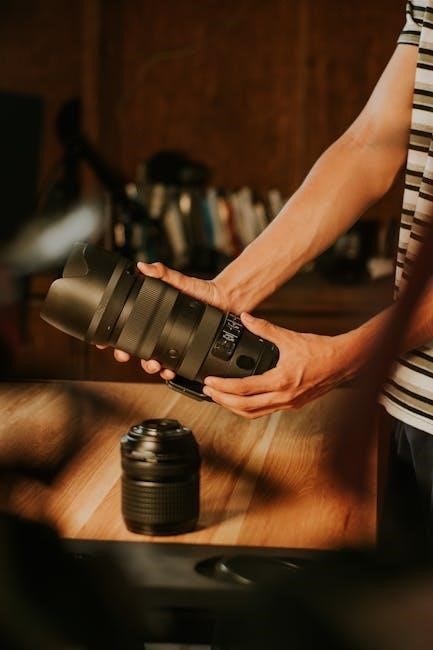
Key Features and Specifications
The Nikon D7100 features a 24.1MP APS-C sensor, 51-point autofocus, ISO 100-6400 (expandable to 25600), 6fps burst mode, and a 3.2-inch LCD screen for enhanced photography experiences.
2.1 Sensor and Image Quality
The Nikon D7100 is equipped with a 24.1-megapixel APS-C CMOS sensor, delivering high-resolution images with excellent detail and color accuracy. The sensor’s design ensures minimal noise and enhanced dynamic range, making it suitable for both bright and low-light conditions. Additionally, the absence of an optical low-pass filter (OLPF) allows for sharper images, capturing intricate textures and finer details. This feature-rich sensor is complemented by Nikon’s EXPEED 3 image-processing engine, which improves overall performance and image quality, ensuring photographers achieve professional-grade results consistently.
2.2 ISO Range and Noise Performance
The Nikon D7100 offers an impressive ISO range of 100 to 6400, extendable to 25600 in Hi mode, ensuring versatility in various lighting conditions. The camera excels in low-light photography, producing images with minimal noise and excellent detail retention. The advanced noise reduction system, combined with the EXPEED 3 processor, effectively minimizes grain, even at higher ISO settings. This capability allows photographers to capture sharp, clear images in challenging environments without compromising quality, making the D7100 a reliable choice for both professionals and enthusiasts.
2.3 Autofocus System
The Nikon D7100 features a robust 51-point autofocus system, powered by the Multi-CAM 3500DX AF sensor, offering precise and rapid subject tracking. With 15 cross-type sensors, it excels in capturing sharp images, even in challenging lighting conditions. The AF system supports a wide range of modes, including Single-Servo AF for stationary subjects and Continuous-Servo AF for dynamic action photography. Additionally, the camera allows for custom AF settings, enabling photographers to tailor focus behavior to their shooting style. This advanced autofocus system ensures reliable performance, making it ideal for capturing high-speed action and intricate details with ease and accuracy.
2.4 Burst Mode and Frame Rate
The Nikon D7100 supports burst mode, capturing up to 6 frames per second in continuous high-speed mode, making it ideal for action and wildlife photography; The camera’s buffer allows for up to 100 shots in JPEG format or 6 RAW files before slowing down. This feature is particularly useful for capturing fleeting moments. Additionally, the KCH settings enable customizable burst modes, allowing photographers to tailor the frame rate to their specific needs. With its robust burst capabilities, the D7100 delivers reliable performance for fast-paced shooting scenarios, ensuring sharp and dynamic images every time.
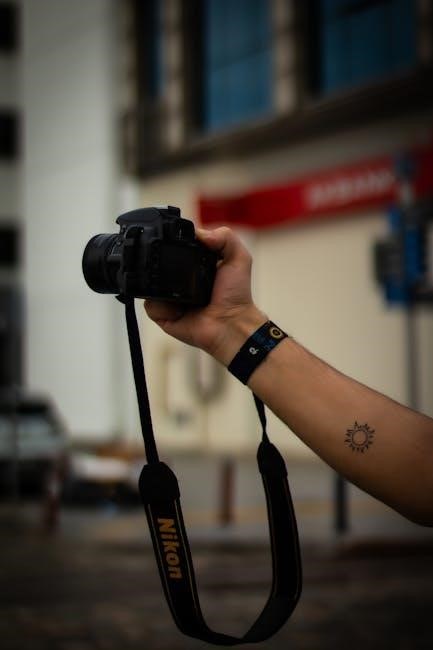
Camera Controls and Buttons
The Nikon D7100 features an intuitive layout with top panel controls for ISO, exposure compensation, and metering modes. The back panel includes buttons for playback, menu, and focus modes, while the mode dial offers quick access to shooting settings, ensuring efficient operation during photography sessions.
3.1 Top Panel Controls
The top panel of the Nikon D7100 includes essential controls for quick access. The mode dial allows selection of shooting modes, while the ISO button adjusts sensitivity. The exposure compensation button fine-tunes brightness, and the metering mode button switches between metering options. A hot shoe accommodates external flashes, and a sync terminal supports off-camera lighting. The command dial adjusts aperture or shutter speed, depending on the mode. These controls are strategically placed for intuitive operation, ensuring photographers can make adjustments without missing a shot. Proper use of these buttons enhances workflow and image quality.
3.2 Back Panel Buttons and Dials
The back panel of the Nikon D7100 is equipped with intuitive buttons and dials for seamless navigation and control. The Playback button allows reviewing images, while the Menu button accesses the camera’s extensive settings. The OK button confirms selections, and the zoom in and zoom out buttons enable detailed image review. A multi-selector navigates menus and selects AF points. The command dial adjusts settings like aperture and shutter speed. These controls are ergonomically designed, ensuring easy access to key functions during shooting or playback, enhancing overall usability and efficiency.
3.3 Mode Dial and Shooting Modes
The Nikon D7100 features a convenient mode dial on the top panel, offering multiple shooting modes to suit various photography needs. The dial includes Auto mode for beginners, Program Auto (P) for flexibility, Aperture Priority (A), Shutter Priority (S), and Manual (M) for full creative control. Additional options like Scene modes provide preset settings for specific scenarios, such as portraits, landscapes, and sports. The mode dial allows quick access to these settings, enabling photographers to adapt to different shooting conditions effortlessly. This versatility makes the D7100 suitable for both novice and advanced users, catering to a wide range of photographic demands.

Menu System and Customization
The Nikon D7100’s menu system is user-friendly, allowing easy navigation and customization of settings. It provides options to tailor camera functions to individual preferences for optimal performance.
4.1 Navigating the Menu
Navigating the Nikon D7100’s menu is straightforward. Use the multi-selector to scroll through options and the OK button to select. The menu is organized into sections like Shooting, Custom Settings, and Setup for easy access. Each tab is color-coded for quick identification. Submenus allow detailed adjustments, such as white balance and autofocus settings. The menu guide provides descriptions for each option, helping users understand and customize their camera effectively. This intuitive system ensures seamless operation, making it easy to tailor the camera to your needs. Efficient navigation enhances the overall shooting experience.
4.2 Custom Settings and User Preferences
The Nikon D7100 allows extensive customization to suit individual preferences. Users can adjust settings like autofocus modes, metering patterns, and bracketing options. Custom settings are stored in the camera’s memory, enabling quick access during shoots. The “Save/Load Settings” feature lets you transfer configurations to a memory card, ensuring consistency across devices. Additionally, the “User-Defined Modes” (U1, U2) on the mode dial can be programmed with specific settings for instant recall. This level of personalization enhances workflow efficiency and allows photographers to tailor the camera to their unique shooting styles and creative visions. Customization options are detailed in the manual for optimal utilization.

Shooting Modes and Techniques
The Nikon D7100 offers a variety of shooting modes and advanced techniques to capture stunning images. Explore automatic modes, manual controls, and specialized settings for optimal results in every situation.
5.1 Automatic Modes (i, P, A, S, M)

The Nikon D7100 features automatic modes such as Auto (i), Programmed Auto (P), Aperture Priority (A), Shutter Priority (S), and Manual (M). Each mode offers unique control levels, catering to different photography needs. Auto mode simplifies operation for beginners, while the semi-automatic modes allow for creative adjustments. Manual mode provides full control over aperture, shutter speed, and ISO, enabling precise results. These modes ensure versatility, making the D7100 suitable for various shooting scenarios, from casual snapshots to professional-level photography. Understanding each mode’s functionality enhances your ability to capture images with desired effects efficiently.
5.2 Advanced Shooting Techniques
The Nikon D7100 supports advanced techniques like bracketing, HDR, and focus stacking for enhanced creativity. Bracketing allows capturing multiple exposures for later merging, ideal for high-contrast scenes. HDR combines images for natural-looking results. Focus stacking sharpens depth in macro or landscape shots. Additionally, interval shooting enables time-lapse photography by setting intervals between frames. These techniques, along with manual focus and RAW image capture, provide professionals with tools for precise control and artistic expression. Experimenting with these features unlocks the D7100’s full potential, helping photographers achieve stunning, professional-grade results in various shooting conditions. Mastering these techniques ensures versatility and creativity in your photography workflow.

Image Quality and Settings
The Nikon D7100 delivers exceptional image quality with its 24.71 MP sensor, capturing sharp details and vibrant colors. Adjust settings like JPEG, RAW, and white balance to customize output, ensuring optimal results in various lighting conditions.
6.1 JPEG vs. RAW Format
The Nikon D7100 allows shooting in both JPEG and RAW formats, each with unique advantages. JPEG offers smaller file sizes and instant readability, ideal for sharing and quick workflows. RAW, however, captures all sensor data, providing maximum flexibility for post-processing and preserving image details. For professional editing, RAW is recommended, while JPEG suits everyday use. The D7100 supports simultaneous recording of both formats, giving users flexibility in their workflow. Understanding these formats is crucial for optimizing image quality and storage efficiency, ensuring the best results in various photographic scenarios.
6.2 White Balance and Picture Controls
The Nikon D7100 offers precise control over White Balance, ensuring accurate color reproduction in various lighting conditions. Options include Auto, Daylight, Shade, Fluorescent, and custom settings. Picture Controls allow users to customize image styles, with options like Standard, Neutral, Vivid, and more. These settings adjust contrast, saturation, and sharpening to suit personal preferences or specific genres of photography. By fine-tuning White Balance and Picture Controls, photographers can enhance image quality and achieve their desired aesthetic, making these tools essential for creative and professional workflows.

Video Recording and Features
The Nikon D7100 supports HD video recording at 1080p with frame rates up to 60p, offering smooth motion capture and detailed video output.
7.1 HD Video Capabilities
The Nikon D7100 offers impressive HD video recording with resolutions up to 1080p at 60p, ensuring smooth and detailed footage. It supports 1080p at 30p, 25p, and 24p, as well as 720p at 60p for slower motion. The camera features manual focus control during recording and allows adjustments to exposure settings for enhanced creativity. An external microphone jack is included for high-quality audio capture, reducing wind noise and improving sound quality. These capabilities make the D7100 a versatile tool for videographers, offering professional-grade video performance in a durable DSLR body.
7.2 Audio and Video Settings
The Nikon D7100 provides a range of audio and video settings to customize your recording experience. Audio levels can be adjusted manually or set to automatic, and the built-in microphone sensitivity can be controlled to reduce wind noise. The camera also supports external microphones via a 3.5mm jack for superior sound quality. Video settings allow for adjustments in frame rates, resolution, and encoding, with options to shoot in HD or standard definition. Additionally, the D7100 offers time-lapse and interval shooting modes, enabling the creation of dynamic and professional-looking video content with ease and precision.

Maintenance and Troubleshooting
Regularly clean the sensor and camera body to maintain performance. Reset user settings to factory defaults if issues arise. Check for firmware updates to ensure optimal functionality and resolve common errors like camera freezing or unexpected shut-downs. Refer to the manual for detailed troubleshooting steps and solutions to ensure your Nikon D7100 operates at its best.
8;1 Cleaning the Sensor and Camera
Regular cleaning of the Nikon D7100’s sensor and camera body is essential for maintaining image quality. Turn off the camera and use a soft, dry cloth to wipe the exterior. For the sensor, use a hand-held blower to remove dust. Avoid touching the sensor surface. If necessary, use a swab with a cleaning solution, but only as instructed in the manual. Never use liquid cleaners on the sensor. For stubborn spots, enable the Mirror Lock-Up feature to access the sensor. Clean in a dust-free environment and avoid extreme temperatures. Refer to the manual for detailed steps to ensure safe and effective cleaning.
8.2 Common Issues and Solutions
Common issues with the Nikon D7100 include error messages, blurred images, or autofocus malfunctions. If the camera displays an error, restart it or check lens connections. For blurry photos, ensure autofocus is enabled and settings are correct. If the camera freezes, reset it using the two-button reset method. Clean the sensor regularly to prevent dust spots. Update firmware to resolve software-related issues. For connectivity problems, ensure cables are securely connected. Refer to the manual for troubleshooting steps or contact Nikon support for persistent issues. Regular maintenance and proper handling can prevent many common problems. Always use genuine Nikon accessories to avoid compatibility issues.
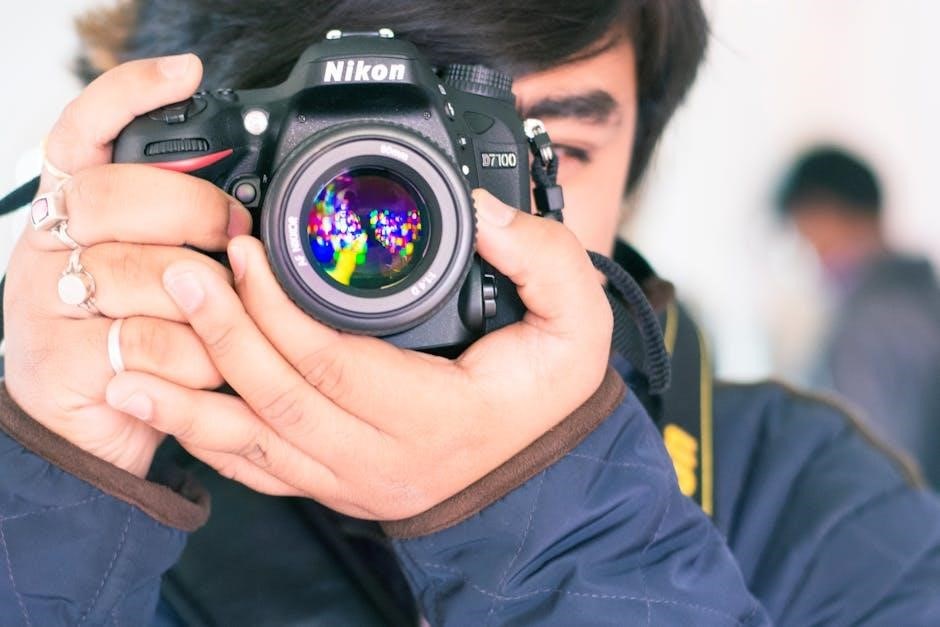
Additional Resources
Access the Nikon D7100 manual online, explore official guides, and download PDF resources for in-depth learning and troubleshooting. Visit Nikon’s website for updated support materials.
9.1 Downloading the PDF Manual
The Nikon D7100 user manual is available for free download in PDF format from Nikon’s official website. This comprehensive guide covers all camera features, settings, and troubleshooting tips. To access it, visit the Nikon support page, select your camera model, and choose the manual from the available downloads. Ensure you have Adobe Reader installed to view the document. The PDF manual is ideal for offline use, allowing you to reference instructions anytime, whether you’re at home or on location. Regularly check for updates to ensure you have the latest version.
9.2 Online Guides and Tutorials
Supplement your learning with online guides and tutorials specifically designed for the Nikon D7100. Nikon’s official website offers detailed video tutorials and articles to help you master the camera’s features. Additionally, photography forums and websites provide user-generated tips and troubleshooting advice. These resources are ideal for visual learners and those seeking hands-on examples of advanced techniques. Explore these guides to enhance your understanding of the D7100 and improve your photography skills; They are accessible anytime, making them a valuable resource for ongoing learning and camera optimization.
Mastering the Nikon D7100 requires practice and understanding its features. Use this manual and online resources to unlock its full potential and enhance your photography skills.
10.1 Final Tips for Mastering the Nikon D7100
To fully master the Nikon D7100, practice regularly and experiment with its features. Review the manual and online guides for in-depth insights. Familiarize yourself with shooting modes and custom settings to tailor the camera to your style. Invest in quality lenses and accessories to enhance your photography. Regularly clean and maintain the camera to ensure optimal performance. Practice burst mode for action shots and explore HD video capabilities. Adjust ISO and white balance for precise control. Lastly, experiment with RAW format and picture controls for superior image quality. Keep learning and enjoy capturing stunning moments!
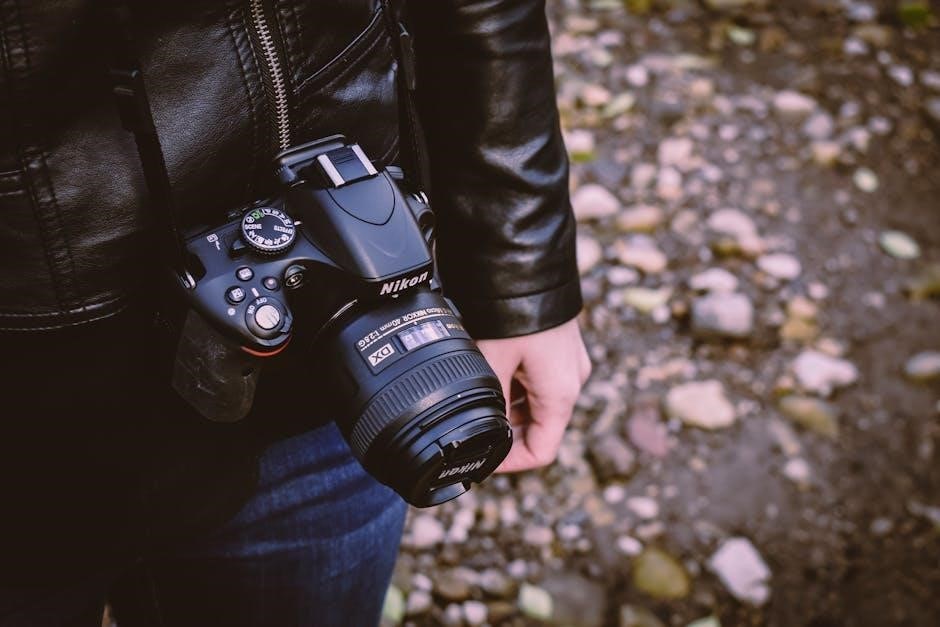
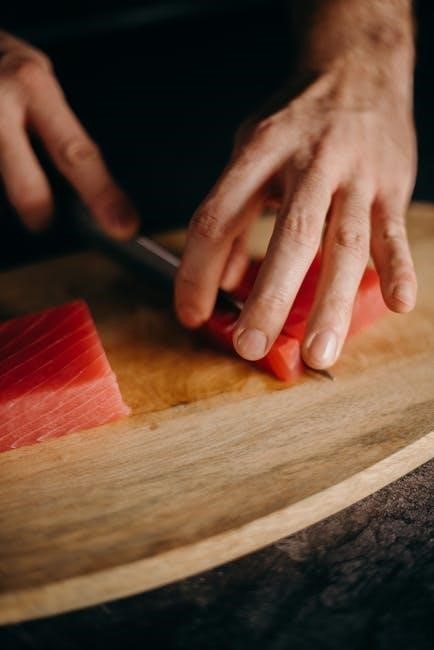


Leave a Reply
You must be logged in to post a comment.